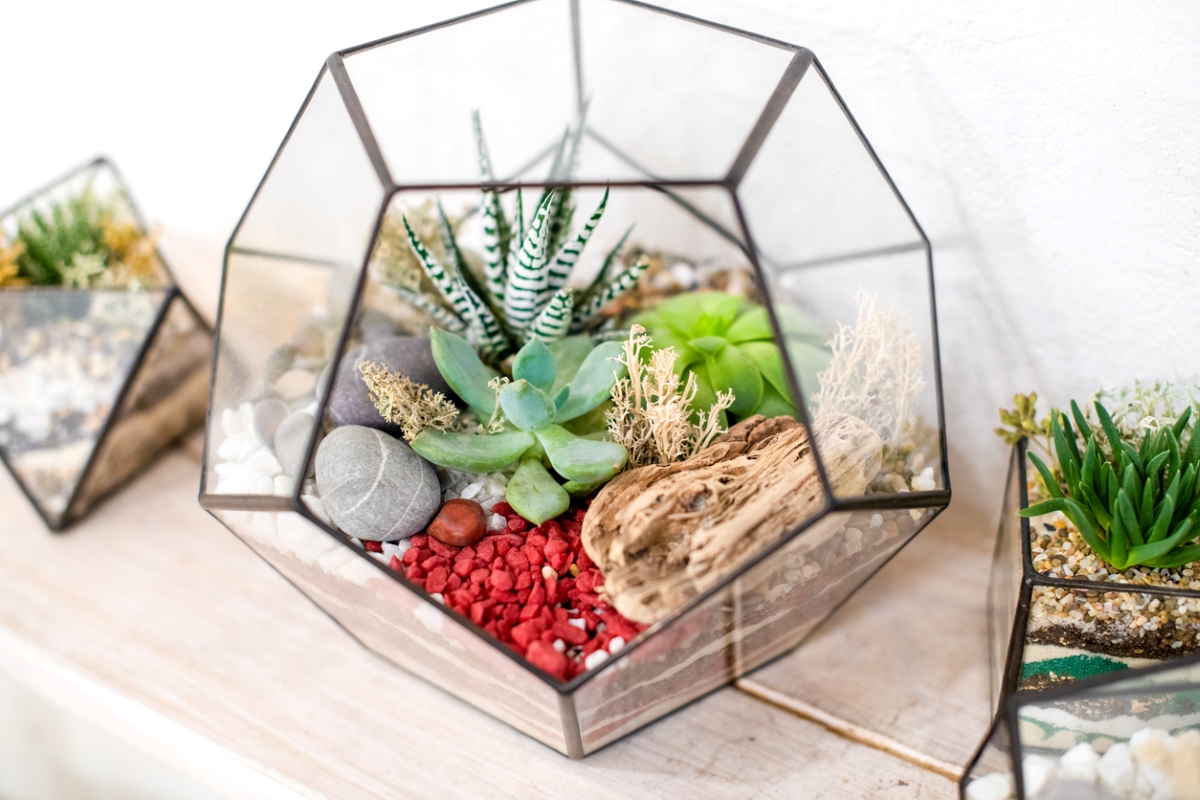

We may earn revenue from the products available on this page and participate in affiliate programs. Learn More ›
If you lack a nature scene outside your windows, try making your own miniature version inside other panes. Although the original closed terrariums keep humidity-loving species flourishing, modern open types also serve as dish gardens for indoor succulent plants instead.
When considering how to make a terrarium, keep in mind what Maria Colletti, author of Terrariums: Gardens Under Glass, considers the most common mistakes people commit during that process. Those include “not utilizing the proper tools for the job, placing plants together that do not have the same environmental requirements, and placing the plants in the container before creating a design.”
Container Considerations
Although it’s easy enough to purchase a terrarium kit online, you probably already have a container or two around the house that you could use for making a DIY terrarium. For a closed terrarium, that could include a fish tank with a hood or a lidded and transparent glass cookie jar, candy jar, or large canning jar. For an open terrarium, a shallow glass container with an open top such as a pie plate, candy dish, or floating candle bowl—minus the water and candle—should work.
Other terrarium ideas include the “ship in a bottle” effect you get by placing your plants in a narrow-necked bottle. Or you can buy a terrarium coffee table and contemplate the beauties of nature while sipping your morning brew. Just don’t exclude light by piling too many newspapers or magazines on top of that table unless it is fitted with interior grow lamps.
Choosing Terrarium Plants
The best terrarium plants for closed containers include those such as ferns that prefer high humidity and only indirect light, as a sealed terrarium should be kept out of the sun to prevent its interior from overheating. An open terrarium often is planted with cacti, succulents, or the desert species of air plants that don’t require much care—or humidity. Although the latter resemble succulents, you actually can use the rainforest species of air plants in a terrarium that isn’t open, since they enjoy humidity and aren’t susceptible to root rot since they lack roots.
However, Colletti emphasizes that “cacti and ferns cannot live together.” Since they do not have the same watering requirements nor the same humidity needs, don’t pair them. “Cacti and succulents need open containers with plenty of ventilation. Ferns and tropical plants love closed glass containers that create a humid wet environment inside where the water recirculates,” Colletti says.
How to Build a Terrarium Step-by-Step
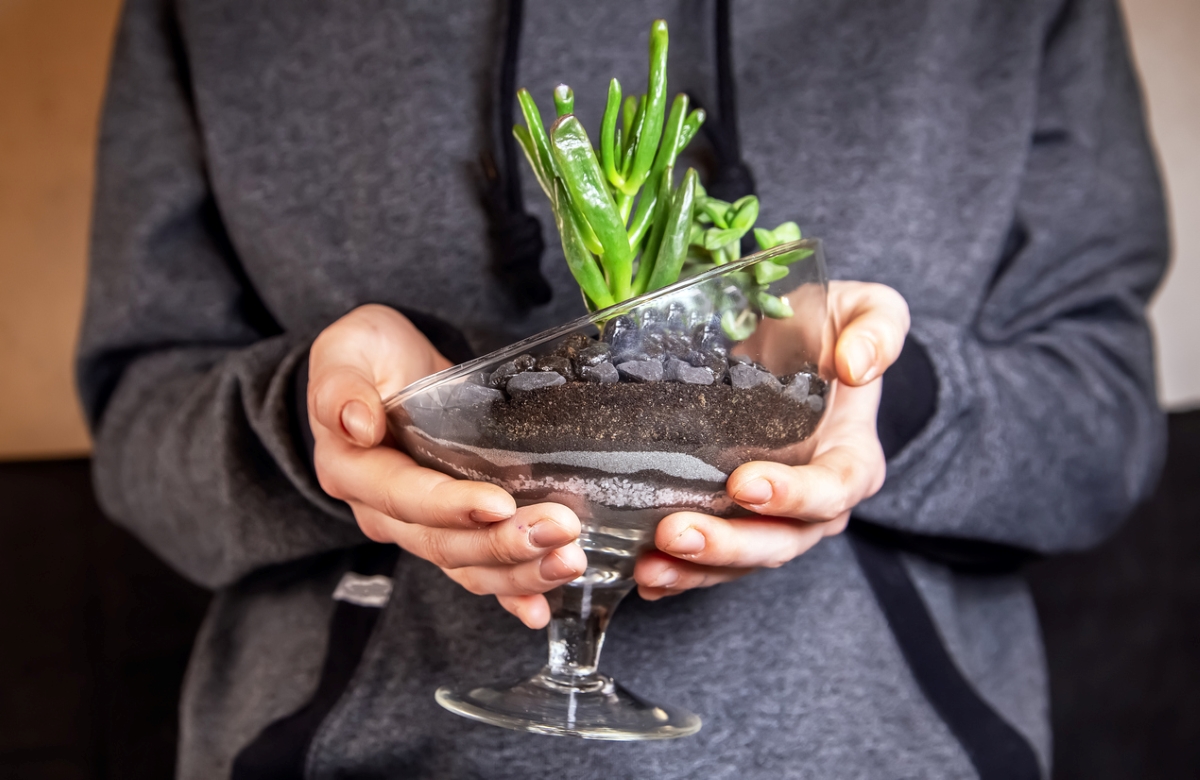
Although you can purchase terrarium supplies such as those listed below for this easiest of indoor gardening projects, you probably can find most of what you need for making a terrarium around your house.
Tools & Materials
Bobvila.com may earn a commission from purchases made through these links.
Project Overview
Working Time: 30 minutes
Total Time: 1 hour
Skill Level: Beginner
Estimated Cost: $50
Before You Begin
When contemplating how to make a terrarium jar, keep in mind that most of the best terrariums are constructed of highly breakable glass. Therefore, homeowners with young children or pets may want to consider transparent plastic containers instead to minimize the possible injuries should a glass container fall and shatter.
STEP 1: Place a layer of gravel and charcoal in your container.
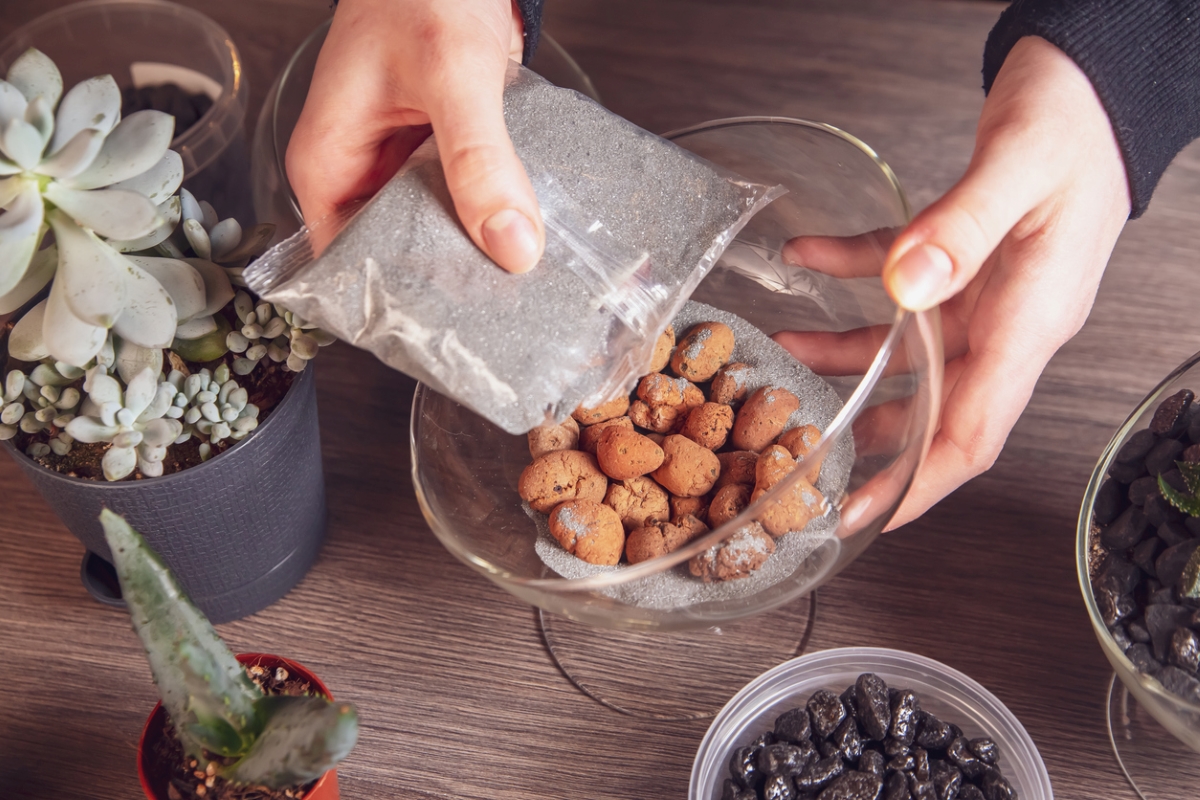
For a large terrarium, use 1½ to 2 inches of the ⅜-inch size pea gravel. You may need to adjust that amount downward for smaller containers. After the gravel is in place, add a ¼-inch layer of horticultural charcoal and mix it thoroughly into the gravel layer. According to Tovah Martin in Flower Magazine, “Charcoal will keep any water that dribbles down to the bottom from going stagnant and smelling swampy.”
STEP 2: Add an appropriate amount of potting mix.
The type of terrarium soil you should use will depend on whether your container is closed or open. For the former type, opt for a standard peat potting mix. If you intend to grow indoor succulents in an open dish garden, use cactus potting soil instead.
The amount of potting mix needed will vary from 1 to 4 inches, depending on how large your terrarium and plants are. Place the soil atop the gravel. The terrarium layers of gravel and “soil” should take up about ¼ (and no more than ⅓) of the container. Use a dry artist’s brush to whisk away any soil still clinging to its upper walls.
STEP 3: Dig holes in the mix to add plants.
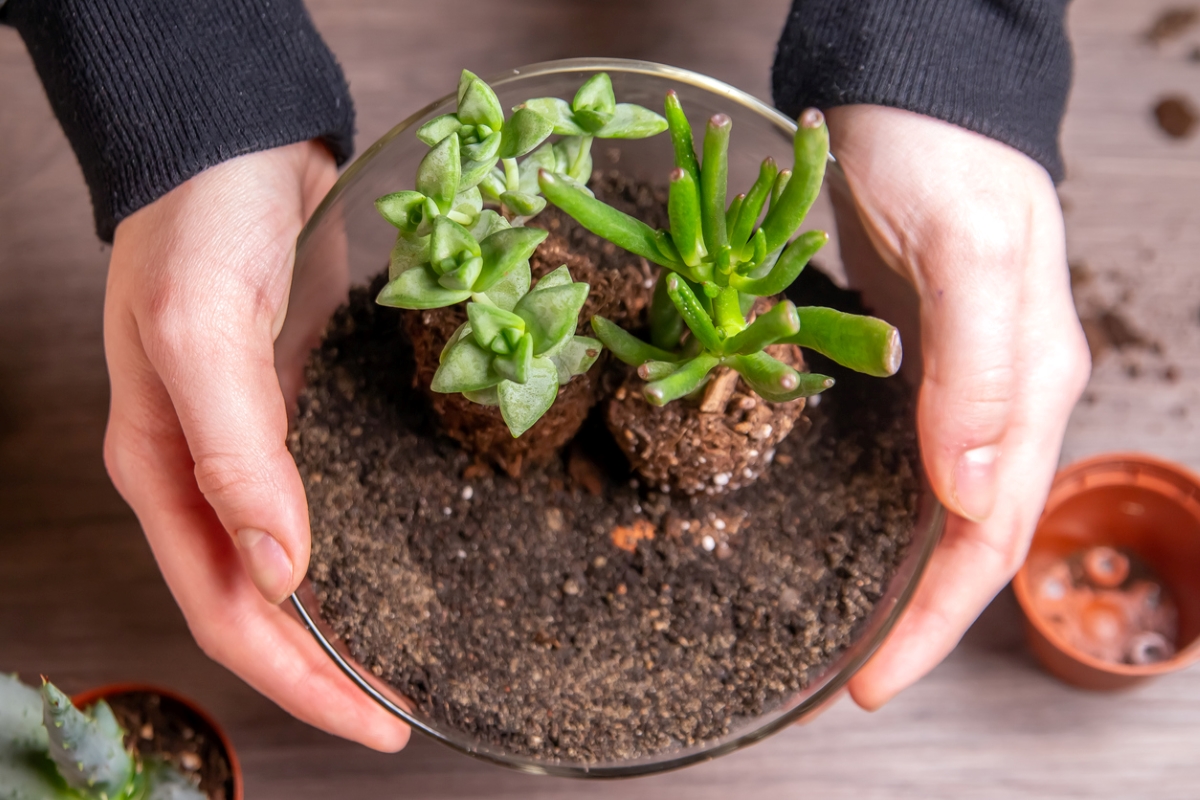
Colletti recommends that you “always use tools such as chopsticks or tongs to place and maneuver the plants into the container” in order to stay in control of precise succulent placement, a cautious method that “keeps the plants from being damaged when you lower them into containers with narrow openings.”
After placing the plants’ roots in the holes, backfill the soil around them, tamping it down firmly. For a terrarium that will be viewed from all sides, place your largest plants in the center and the smallest towards the outside. If it will be viewed from only one side, set the largest species in the back.
STEP 4: Water the plants sparingly so their soil is lightly damp.
You may want to use a kitchen baster to water a deep terrarium since the baster’s long tube can be used to direct the water where you want it to go without the splashing, which can muddy the sides of the container. Or you can just use a watering can with a long spout. In either case, try to get the mix only lightly moist and not soggy, as oversaturated soil in an enclosed container can cause root rot.
STEP 5: Add small movable objects such as stones and animal statuettes.
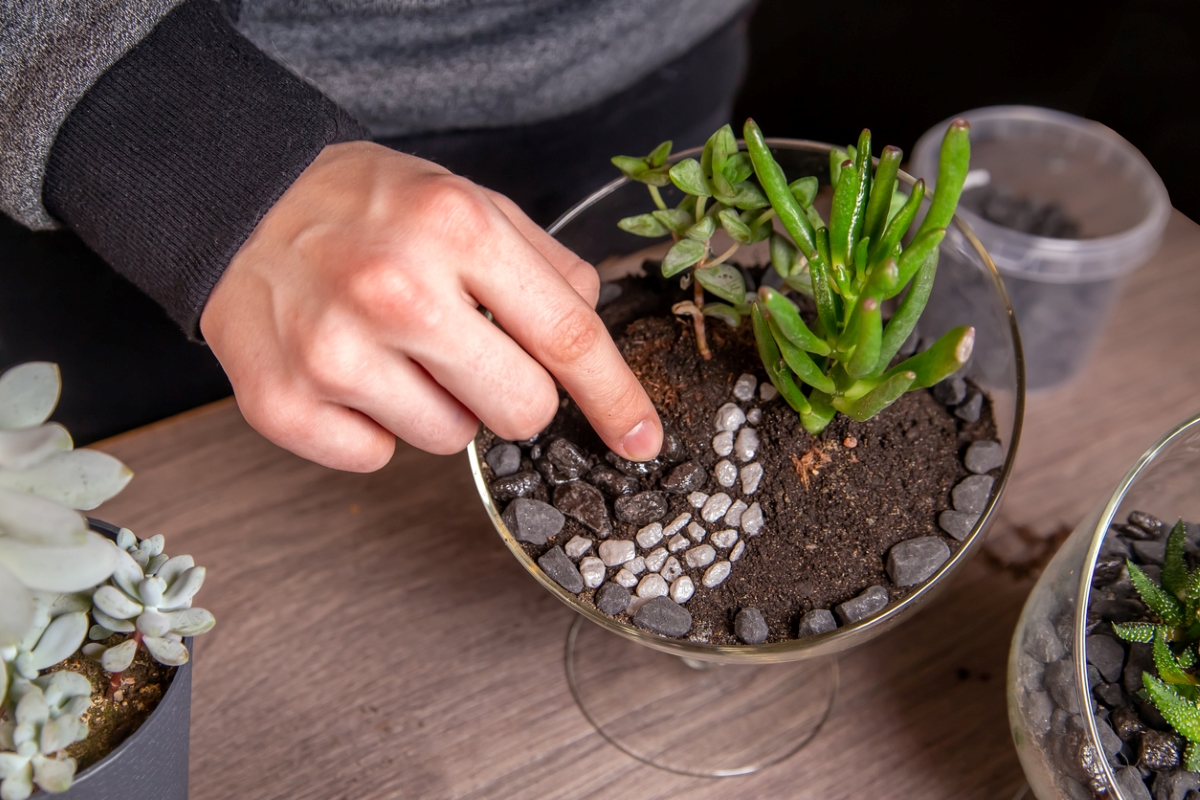
For decor for terrariums, you may want to lay down a carpet of living moss beneath the plants. You also can incorporate small items such as shells and stones or resin miniature amphibians, mushrooms, or fairy garden figurines to give your indoor terrarium an outdoor look.
Air plants, which don’t need soil, may also be added and moved around as needed, since they aren’t tied down by roots. In closed terrariums, avoid items that decay easily, such as those made from wood or paper.
Maintaining a Terrarium
Although plants in terrariums don’t require as much maintenance as other plants, they still need a little.
- Keep a closed terrarium in a position where it receives bright, indirect light but no direct sun.
- Place an open cacti and succulent terrarium in either a sunny position or bright, indirect light, depending on the requirements of the plants you have chosen.
- Water closed terrarium jars only enough that they show a little condensation on the glass but not enough moisture to conceal or coat the plants inside.
- If too much condensation builds up, leave the lids off the containers for a while until the moisture dissipates.
- Water a cacti and succulent terrarium planter only after its soil has dried out completely, but don’t leave it dry for long enough that the plants begin to shrivel.
- Air plants in open terrariums should be removed and briefly soaked about once per week, then turned upside down and allowed to dry before being returned to their places.
Final Thoughts
If you follow the above hints and warnings on how to build a terrarium, you should be able to keep the plants inside your terrarium containers happy for a while. In fact, they may become so happy that they begin to outgrow their space.
In that case, you might want to graduate them to the status of stand-alone houseplants and start over with a new cast of younger plants for a change of scenery. Just be sure to clean your containers thoroughly and add fresh potting mix first.
